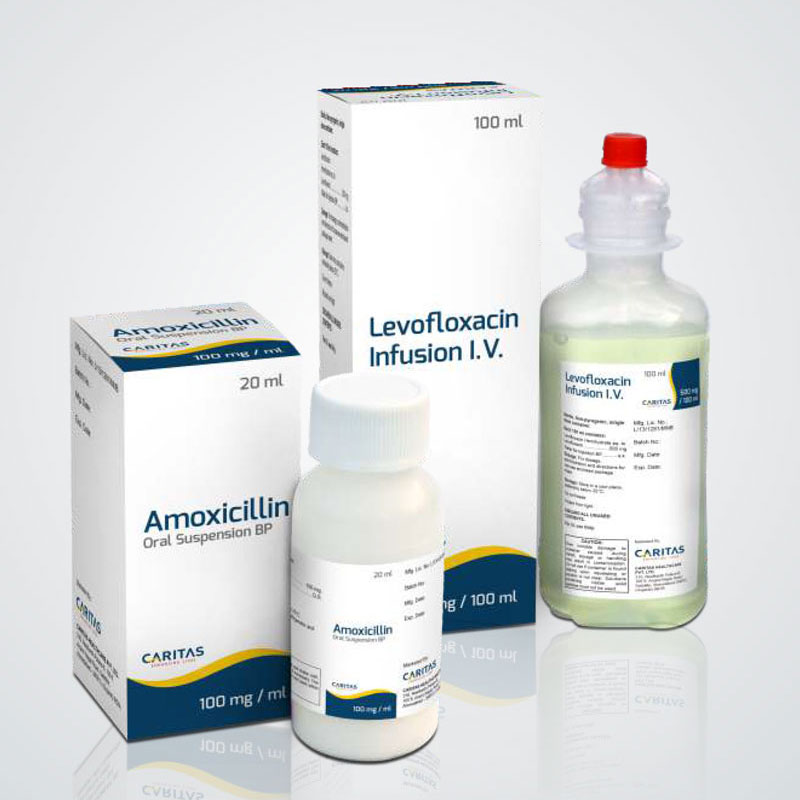PHARMACOLOGICAL CLASSIFICATION:
Semi synthetic Penicillinase suspeptible penicillin
PHARMACOLOGICAL ACTION:
Amoxicillin is a semi-synthetic aminopenicillin of the beta-lactam group of antibiotics. Amoxicillin has a broad spectrum of antibacterial activity against many Gram-positive and Gram-negative microorganisms, acting through the inhibition of biosynthesis of cell wall mucopeptide. Amoxicillin is active in vitro against beta-lactamase negative strains of Proteus mirabilis and Haemophilus influenza. In vitro studies have also demonstrated activity against most strains of alpha- and beta-haemolytic streptococci. Streptococcus pneumoniae and beta-lactamase negative strains of staphylococci, Neisseria gonorrhoeae, Neisseria, meningitidis and Enterococcus faecalis. However, some of the organisms are sensitive to amoxicillin only at concentrations achieved in the urine. Strains of gonococci which are relatively resistant to benzyl penicillin may also be resistant to amoxicillin. Amoxicillin is susceptible to degradation by beta- lactamases and therefore it is ineffective against bacteria which produce these enzymes particularly resistant staphylococci, which now have a high prevalence. All strains of Pseudomonas, Klebsiella and Enterobacter, indole positive Proteus,Serratia marcescens, Citrobacter, penicillinase producing N. gonorrhoeae and penicillinase producing H. influenzae are also resistant. Escherichia coli isolates are becoming increasingly resistant to amoxicillin in vitro due to the presence of penicillinase- producing strains.
Susceptible Gram-positive aerobes include: Enterococcus faecalis (Note 2), Streptococcus pneumoniae (Notes 1, 3). Streptococcus pyogenes (Notes 2, 3), Streptococcus viridans (Note 2), Streptococcus agalactlae, Streptococcus bavis, Staphylococcus aureus {penicillin sensitive), Corynebacterium species (Note 2), Bacillus anthracis, Listeria monocytogenes
Susceptible Gram-negative aerobes include: Haemophilus Influenzae {Note 3), Haemophilus parainfluenzae (Note 3), Escherichia coli (Note 3), Proteus mirabilis, Salmonella species (Note 2), Shigella species (Note 2), Bordetella pertussis, Brucella species (Note 1), Neisseria gonorrhoeae (Note 2), Neisseria meningitidis (Note 1), Posteureila septica, Helicobacter pylori, leptospira spp, Vibrio Cholerae
Susceptible anaerobes include: Bacteroides melaninogenicus (Note 2) Clostridium species, Fusobacterium spp: (Note 2), Peptostreptococi. Other susceptible organisms include Borrelia burgdorferi.
PHARMACOKINETICS
Absorption : Amoxicillin is stable in the presence of gastric acid and rapidly absorbed from the gut to an extent of 0.72 to 93%. Absorption is independent of food intake. Peak blood levels are achieved 1 to 2 hours after administration. After 250 and 500 mg doses of amoxicillin, average peak serum concentrations of 5.2 mcg/ml and 8.3 mcg/ml respectively have been reported.
Distribution : Amoxicillin is not highly protein bound. Approximately 18% of total plasma drug content is bound to protein. Amoxicillin diffuses readily into most body tissues and fluids, including sputum and saliva but not the brain and spinal fluid. Inflammation generally increases the permeability of the meninges to penicillins and this may apply to amoxicillin. Amoxicillin diffuses across the placenta and a small percentage is excreted into the breast milk.
Bio transformation : Amoxicillin is excreted mainly via the urine where it exists in a high concentration. Amoxicillin is also partly excreted in the urine as the inactive penicilloic acid in quantities equivalent to 10 to 25% of the initial dose. Small amounts of the drug are also excreted in faeces and bile. Concentrations in the bile may vary and are dependent upon normal biliary function.
Elimination : Approximately 60 to 70% of amoxicillin is excreted unchanged in urine during the first 6 hours after administration of a standard dose. The elimination half life is approximately 1 hour. Concurrent administration of probenecid delays amoxicillin excretion. In patients with end-stage renal failure, the half-life ranges between 5-20 hours. The substance is haemodialysable.
Upper respiratory tract infections, Genito- urinary tract infections, skin and soft tissue infections.
For upper respiratory tract infections due to streptococci, pneumococci, non penicillinase producing staphylococci and H. influenzae or Genito-Urinary Tract Infections (due to Escherichia coli, Proteus mirabilis and Streptococcus faecalis or Skin and Soft Tissue Infections due to streptococci, sensitive staphylococci Escherichia coli
Adults : 250 mg every 8 hours. Children (under 20 kg): 25 mg/kg/day in equally divided doses every 8 hours. In severe infections or those caused by less susceptible organisms, 500 mg every 8 hours for adult and 50 mg/kg/day in equally divided doses every 8 hours for children may be needed.
Lower respiratory tract infections : For lower respiratory tract infections (due to streptococci, pneumococci, non-penicillinase producing staphylococci and H. influenzae: Adults: 500mg every 8 hours. Children (under 20 kg): 50 mg/kg/day in equally divided doses every 8 hours.
Treatment duration : Treatment should be continued for a minimum of 48 to 72 hours beyond the time that the patient becomes asymptomatic or evidence of bacterial eradication has been obtained. It is recommended that there be at least 10 days treatment for any infection caused by haemolytic streptococci to prevent the occurrence of rheumatic fever or glomerulonephritis.
| GENERIC NAME | PHARMACEUTICAL FORM | CONCENTRATION |
|---|---|---|
| Acetylcysteine solution | Solution | 20% |
| Acetylcysteine Tablets | Tablets | 600mg |
| Aciclovir sodium Infusion | Infusion | 250mg |
| Amoxycillin & Clavulonate Potassium Injection | Injection | 0.6gm, 1.2gm |
| Azithromycin Injection | Powder for Injection | 500mg |
| Azithromycin Tablets | Tablets | 250mg, 500mg |
| Aztreonam powder for Injection | Powder for Injection | 500mg, 1gm |
Infections caused by susceptible, non-penicillinase producing organisms including: Upper respiratory tract infections, Lower respiratory tract infections, Otitis media, Typhoid Fever, Upper urinary tract infections, Lower urinary tract infections, Skin and soft tissue infections, Gastro- intestinal tract infections, Gonorrhoea, Non-specific urethritis.
Inflammation generally increases the permeability of the meninges to penicillins and this may apply to amoxicillin. Amoxicillin diffuses across the placenta and a small percentage is excreted into the breast milk.

